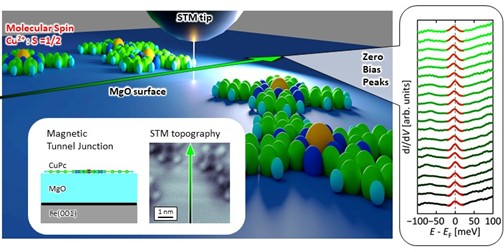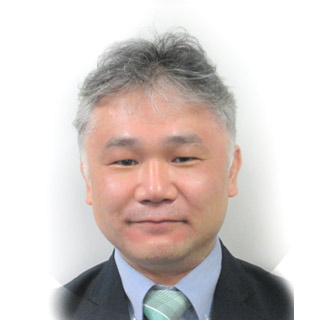Researchers successfully realized a stable, isolated quantum spin on an insulating thin film laid over a magnetic surface
Creating stable isolated spins is crucial for quantum-spin applications, like quantum bits or qubits, sensors, and single-atom catalysts. Currently, most approaches include engineering isolated spins on noble metal surfaces, whose abundant conduction electrons can also disturb their spin state. In a new study, researchers successfully demonstrated for the first time isolated spins on an insulating magnesium oxide film, laid over a ferromagnetic iron substrate, suggesting a new pathway towards realizing qubits using conventional thin-film techniques.

Image title: Realizing an isolated spin-state on magnesium oxide (MgO)/ferromagnetic Fe(001) interface.
Image caption: The researchers successfully realized a stable isolated spin state on an insulating MgO thin film, laid over a ferromagnetic Fe(001) substrate, marking a significant achievement. This shows that qubits can be developed through conventional thin-film techniques.
Image credit & source link: Dr. Toyo Kazu Yamada from Chiba University, Japan
https://pubs.rsc.org/en/content/articlelanding/2025/nh/d5nh00192g
Image license: CC BY 3.0
Usage restrictions: Credit must be given to the creator.
Establishing robust isolated spins on solid surfaces is crucial for fabricating quantum bits or qubits, sensors, and single-atom catalysts. An isolated spin is a single spin that is shielded from external interactions. Because isolated spins can maintain their state for long periods, they are ideal for use as qubits, the basic units of quantum computation, and for ultrafast spintronic memory.
Consequently, significant research has been dedicated to identifying materials capable of producing a stable isolated quantum spin. Candidates include single atoms of transition metals such as copper (Cu) in the Cu-phthalocyanine molecule (CuPc), molecular magnets, nitrogen-vacancy centres in diamonds, and two-dimensional layered materials. One way to detect an isolated spin is by observing a zero-bias peak (ZBP) in the electrical conductance of, for example, a noble metal substrate containing a CuPc molecule. The ZBP results from the interaction between conduction electrons on the substrate and the isolated spin.
So far, the engineering of these ZBPs has been mainly limited to noble metal surfaces, like gold and silver. These surfaces are rich in conduction electrons, which, while useful for ZBP, can also scatter a spin and flip its state, causing it to disturb the intrinsic spin state. This makes them unsuitable for use as qubits. As a solution, researchers have turned to insulating films, which lack conduction electrons and can host more stable spins.
In a breakthrough, a research team led by Associate Professor Toyo Kazu Yamada from the Graduate School of Engineering at Chiba University, Japan, demonstrated for the first time isolated spins on an insulating solid surface laid over a magnetic substrate. “In this study, we successfully realized isolated spins on an insulating magnesium oxide (MgO) surface placed on a ferromagnetic iron substrate–Fe(001),” explains Dr. Yamada. “Since insulating surfaces do not have conduction electrons, quantum spins can remain more stable. Moreover, the MgO/Fe(001) structure that we used is already widely used in spintronics, making our approach highly accessible.” The team also included Mr. Kyoei Ishi, Dr. Nana Nazriq, and Dr. Peter Krüger, also from Chiba University. Their study was published online in the journal Nanoscale Horizons on July 30, 2025.
The researchers, in the study, focused on placing a CuPc molecule on a MgO/Fe(001) interface. The first hurdle they faced was to grow an atomically flat MgO layer on an Fe(001) substrate. They found that developing an oxygen coating on Fe(001) can provide an atomically flat surface. This enabled them to epitaxially grow a flat MgO film on the oxygen-coated Fe(001) substrate using chemical vapor deposition in an ultra-high vacuum. Finally, after trial and error, they successfully adsorbed a CuPc molecule onto the insulating MgO surface.
“A unique feature of our design is the use of a ferromagnetic iron substrate,” says Dr. Yamada. “While a magnetic surface would normally interact with and change the state of an isolated spin, the insulating layer between the substrate and the CuPc molecule prevents direct interaction, keeping the spin stable.”
To confirm the presence of isolated spins, they conducted scanning tunnelling spectroscopy of the fabricated sample and looked for a ZBP. Since MgO lacks conduction electrons, they did not initially expect a ZBP to appear. However, upon close examination, they clearly observed a clear ZBP that emerged via indirect coupling of the isolated spin and conduction electrons in the Fe(001) substrate through the MgO surface. This suggests that insulating films can support the formation of isolated spins, even on ferromagnetic substances. Interestingly, the ZBP also appeared on the MgO surface outside the CuPc, which is not found in noble metal surfaces.
“Our study marks a remarkable achievement for research on isolated spins,” remarks Dr. Yamada. “Because the MgO/Fe(001) surface is already widely used in tunnel magnetoresistance devices, our findings suggest it may be possible to integrate qubits using existing thin-film fabrication methods.”
This groundbreaking study opens a new direction for isolated spin research, posing magnetic substrates, already widely used in spintronic devices, as a new platform for holding and manipulating qubits, paving the way for more accessible quantum computing.
To see more news from Chiba University, click here.
About Associate Professor Toyo Kazu Yamada
Dr. Toyo Kazu Yamada currently holds the position of Associate Professor in the Department of Materials Science at Chiba University, Japan. He earned his Ph.D. (double degree) in 2004 from Radboud University Nijmegen, The Netherlands; and Gakushuin University, Japan. Additionally, he served as a Humboldt research fellow at the Karlsruhe Institute of Technology from 2008 to 2010. His research interests include spintronics, thin film and nanotechnology, surface science, and quantum spins, among others.
Funding:
This work was supported by JSPS KAKENHI Grant Number 23H02033, the Murata Science Foundation, the Shorai Foundation for Science and Technology, the TEPCO Memorial Foundation, the Casio Science Promotion Foundation, and the Toshiaki Ogasawara Memorial Foundation.
Reference:
Title of original paper: Emergence of a zero-bias peak on the MgO/Fe(001) surface induced by the adsorption of a spin-1/2 molecule
Authors: Kyosei Ishiia, Nana K. M. Nazriqa,Peter Krügera,b, and Toyo Kazu Yamadaa,b
Affiliations: aDepartment of Materials Science, Chiba University
bMolecular Chirality Research Centre, Chiba University
Journal: Nanoscale Horizons
DOI: 10.1039/D5NH00192G
Contact: Toyo Kazu Yamada
Graduate School of Engineering, Chiba University
Email: toyoyamada@faculty.chiba-u.jp
Academic Research & Innovation Management Organization (IMO), Chiba University
Address: 1-33 Yayoi, Inage, Chiba 263-8522 JAPAN
Email: cn-info@chiba-u.jp
Recommend
-

Towards a self-sustainable natural environment: The science of restoration ecology, where researchers engage in conversation with the earth
2023.02.02
-

Unlocking the Potential of Plant Molecules: Charting a New Continent in Natural Products Biology
2024.09.30
-

Evolutionary Psychology: A Path to a Nature-Positive Future for Biodiversity
2025.01.31


